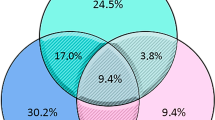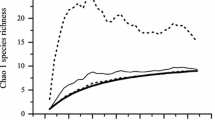Abstract
We investigate the diversity of yeasts isolated in gardens of the leafcutter ant Atta texana. Repeated sampling of gardens from four nests over a 1-year time period showed that gardens contain a diverse assemblage of yeasts. The yeast community in gardens consisted mostly of yeasts associated with plants or soil, but community composition changed between sampling periods. In order to understand the potential disease-suppressing roles of the garden yeasts, we screened isolates for antagonistic effects against known microfungal garden contaminants. In vitro assays revealed that yeasts inhibited the mycelial growth of two strains of Escovopsis (a specialized attine garden parasite), Syncephalastrum racemosum (a fungus often growing in gardens of leafcutter lab nests), and the insect pathogen Beauveria bassiana. These garden yeasts add to the growing list of disease-suppressing microbes in attine nests that may contribute synergistically, together with actinomycetes and Burkholderia bacteria, to protect the gardens and the ants against diseases. Additionally, we suggest that garden immunity against problem fungi may therefore derive not only from the presence of disease-suppressing Pseudonocardia actinomycetes, but from an enrichment of multiple disease-suppressing microorganisms in the garden matrix.


Similar content being viewed by others
References
Adams AS, Six DL, Adams SM, Holben WE (2008) In vitro interactions between yeasts and bacteria and the fungal symbionts of the mountain pine beetle (Dendroctonus ponderosae). Microb Ecol 56:460–466. doi:10.1007/s00248-008-9364-0
Altschul SF, Madden TL, Schaffer AA, Zhang J, Zhang Z, Miller W, Lipman D (1997) Gapped BLAST and PSI-BLAST: a new generation of protein database search programs. Nucleic Acids Res 25:3389–3402. doi:10.1093/nar/25.17.3389
Ayres M, Ayres M Jr, Ayres DL, dos Santos AS (2007) BioEstat 5.0. Imprensa Oficial do Estado do Pará, p 323
Ba AS, Phillips SA, Anderson JT (2000) Yeasts in the mound soil of the red imported fire ant. Mycol Res 104:969–973. doi:10.1017/S0953756299002385
Bot ANM, Ortius-Lechner D, Finster K, Maile R, Boomsma JJ (2002) Variable sensitivity of fungi and bacteria to compounds produced by the metapleural glands of leaf-cutting ants. Insectes Soc 49:363–370. doi:10.1007/PL00012660
Cafaro MJ, Currie CR (2005) Phylogenetic analysis of mutualistic filamentous bacteria associated with fungus-growing ants. Can J Microbiol 51:441–446. doi:10.1139/w05-023
Carreiro SC (2000) Pesquisa do fator killer e análise de degradação de polissacarídeos vegetais por leveduras associadas aos ninhos de Atta sexdens. Ph.D. dissertation, Universidade Estadual Paulista
Carreiro SC, Pagnocca FC, Bueno OC, Bacci M Jr, Hebling MJA, Silva OA (1997) Yeasts associated with nests of the leaf-cutting ant Atta sexdens rubropilosa Forel, 1908. Antonie Van Leeuwenhoek 71:243–248. doi:10.1023/A:1000182108648
Carreiro SC, Pagnocca FC, Bacci M Jr, Bueno OC, Hebling MJA, Middelhoven WJ (2002) Occurrence of killer yeasts in leaf-cutting ant nests. Folia Microbiol (Praha) 47:259–262. doi:10.1007/BF02817648
Carreiro SC, Pagnocca FC, Bacci M Jr, Lachance MA, Bueno OC, Hebling MJA, Ruivo CCC, Rosa CA (2004) Sympodiomyces attinorum sp. nov., a yeast species associated with nests of the leaf-cutting ant Atta sexdens. Int J Syst Evol Microbiol 54:1891–1894. doi:10.1099/ijs.0.63200-0
Coelho AR, Celli MG, Ono EYS, Wosiacki G, Hoffmann FL, Pagnocca FC, Hirooka EY (2007) Penicillium expansum versus antagonist yeasts and patulin degradation in vitro. Braz Arch Biol Tech 50:725–733
Craven SE, Dix MW, Michaels GE (1970) Attine fungus gardens contains yeasts. Science 169:184–186. doi:10.1126/science.169.3941.184
Currie CR, Stuart AE (2001) Weeding and grooming of pathogens in agriculture by ants. Proc R Soc Lond B Biol Sci 268:1033–1039. doi:10.1098/rspb.2001.1605
Currie CR, Scott JA, Summerbell RC, Malloch D (1999a) Fungus-growing ants use antibiotic-producing bacteria to control garden parasites. Nature 398:701–704. doi:10.1038/19519
Currie CR, Mueller UG, Malloch D (1999b) The agricultural pathology of ant fungus gardens. Proc Natl Acad Sci USA 96:7998–8002. doi:10.1073/pnas.96.14.7998
Currie CR, Wong B, Stuart AE, Schultz TR, Rehner SA, Mueller UG, Sung GH, Spatafora JW, Straus NA (2003) Ancient tripartite co-evolution in the attine ant–microbe symbiosis. Science 299:386–388. doi:10.1126/science.1078155
Fuentefria AM, Suh S-O, Landell MF, Faganello J, Schrank A, Vainstein MH, Blacwell M, Valente P (2008) Trichosporon insectorum sp. nov., a new anamorphic basidiomycetous killer yeast. Mycol Res 112:93–99. doi:10.1016/j.mycres.2007.05.001
Gadanho M, Libkind D, Sampaio JP (2006) Yeast diversity in the extreme acidic environments of the Iberian pyrite belt. Microb Ecol 52:552–563. doi:10.1007/s00248-006-9027-y
Ganter PF (2006) Yeasts and invertebrates associations. In: Rosa CA, Péter G (eds) The yeast handbook: biodiversity and ecophysiology of yeasts. Springer Verlag, Berlin, pp 263–301
Ganter PF, Starmer WT (1992) Killer factor as a mechanism of interference competition in yeasts associated with cacti. Ecology 73:54–67. doi:10.2307/1938720
Gerardo NM, Jacobs SR, Currie CR, Mueller UG (2006) Ancient host-pathogen associations maintained by specificity of chemotaxis and antibiosis. PLoS Biol 4:e235. doi:10.1371/journal.pbio.0040235
Hall TA (1999) BioEdit: a user-friendly biological sequence alignment editor and analysis program for Windows 95/98/NT. Nucleic Acids Symp Ser 41:95–98
Inácio J, Pereira P, de Carvalho M, Fonseca A, Amaral-Collaço MT, Spencer-Martins I (2002) Estimation and diversity of phylloplane mycobiota on selected plants in a Mediterranean-type ecosystem in Portugal. Microb Ecol 44:344–353. doi:10.1007/s00248-002-2022-z
Kost C, Lakatos T, Böttcher I, Arendholz W-R, Redenbach M, Wirth R (2007) Non-specific association between filamentous bacteria and fungus-growing ants. Naturwissenschaften 94:821–828. doi:10.1007/s00114-007-0262-y
Kurtzman CP, Robnett CJ (1998) Identification and phylogeny of ascomycetous yeasts from analysis of nuclear large subunit (26S) rDNA partial sequences. Antonie Van Leeuwenhoek 73:331–371. doi:10.1023/A:1001761008817
Lachance MA, Starmer WT, Rosa CA, Bowles JM, Barker JFS, Janzen DH (2001) Biogeography of the yeasts of ephemeral flowers and their insects. FEMS Yeast Res 1:1–8
Latham BP (1998) Yeast community persistence in a spatially structured environment. Microb Ecol 36:60–65. doi:10.1007/s002489900093
Liggio J, Liggio AO (1999) Wild orchids of Texas. University of Texas Press, Austin
Little AEF, Currie CR (2008) Black yeast symbionts compromise the efficiency of antibiotic defenses in fungus-growing ants. Ecology 89:1216–1222. doi:10.1890/07-0815.1
Middelhoven WJ, Fonseca A, Carreiro SC, Pagnocca FC, Bueno OC (2003) Cryptococcus haglerorum, sp. nov., an anamorphic basidiomycetous yeast isolated from nests of the leaf-cutting ant Atta sexdens. Antonie Van Leeuwenhoek 83:167–174. doi:10.1023/A:1023384830802
Mikheyev AS, Mueller UG, Abbott P (2006) Cryptic sex and many-to-one co-evolution in the fungus-growing ant symbiosis. Proc Natl Acad Sci USA 103:10702–10706. doi:10.1073/pnas.0601441103
Mikheyev AS, Vo T, Mueller UG (2008) Phylogeography of post-Pleistocene population expansion in a fungus-gardening ant and its microbial mutualists. Mol Ecol 17:4480–4488. doi:10.1111/j.1365-294X.2008.03940.x
Morais PB, Hagler AN, Rosa CA, Mendonca-Hagler LC (1992) Yeasts associated with Drosophila in tropical forests of Rio de Janeiro, Brazil. Can J Microbiol 38:1150–1155
Mueller UG, Rabeling C (2008) A breakthrough innovation in animal evolution. Proc Natl Acad Sci USA 105:5287–5288. doi:10.1073/pnas.0801464105
Mueller UG, Rehner SA, Schultz TR (1998) The evolution of agriculture in ants. Science 281:2034–2038. doi:10.1126/science.281.5385.2034
Mueller UG, Gerardo NM, Aanen DK, Six DL, Schultz TR (2005) The evolution of agriculture in insects. Annu Rev Ecol Evol Syst 36:563–595. doi:10.1146/annurev.ecolsys.36.102003.152626
Mueller UG, Dash D, Rabeling C, Rodrigues A (2008) Coevolution between attine ants and actinomycete bacteria: a reevaluation. Evol Int J Org Evol 62:2894–2912. doi:10.1111/j.1558-5646.2008.00501.x
Nguyen NH, Suh S-O, Marshall CJ, Blackwell M (2006) Morphological and ecological similarities: wood-boring beetles associated with novel xylose-fermenting yeasts, Spathaspora passalidarum gen. sp. nov. and Candida jeffriesii sp. nov. Mycol Res 110:1232–1241. doi:10.1016/j.mycres.2006.07.002
Pagnocca FC, Carreiro SC, Bueno OC, Hebling MJ, da Silva OA (1996) Microbiological changes in the nests of leaf-cutting ants fed on sesame leaves. J Appl Entomol 120:317–320
Pagnocca FC, Rodrigues A, Nagamoto NS, Bacci M Jr (2008) Yeasts and filamentous fungi carried by the gynes of leaf-cutting ants. Antonie Van Leeuwenhoek 94:517–526. doi:10.1007/s10482-008-9268-5
Petersson S, Schnüner J (1995) Biocontrol of mold growth in high-moisture wheat stored under airtight conditions by Pichia anomala, Pichia guilliermondii, and Saccharomyces cerevisae. Appl Environ Microbiol 61:1027–1032
Rodrigues A, Pagnocca FC, Bacci M Jr, Hebling MJA, Bueno OC, Pfenning LH (2005) Variability of non-mutualistic filamentous fungi associated with Atta sexdens rubropilosa nests. Folia Microbiol (Praha) 50:421–425. doi:10.1007/BF02931424
Rodrigues A, Bacci M Jr, Muller UG, Ortiz A, Pagnocca FC (2008a) Microfungal “weeds” in the leafcutter ant symbiosis. Microb Ecol 56:604–614. doi:10.1007/s00248-008-9380-0
Rodrigues A, Carletti CD, Bueno OC, Pagnocca FC (2008b) Leaf-cutting ant faecal fluid and mandibular gland secretion: effects on microfungi spore germination. Braz J Microbiol 39:64–67. doi:10.1590/S1517-83822008000100016
Santos AV, Dillon RJ, Dillon VM, Reynolds SE, Samuels RI (2004) Occurrence of the antibiotic producing bacterium Burkholderia sp. FEMS Microbiol Lett 239:319–323. doi:10.1016/j.femsle.2004.09.005
Schultz TR, Brady SG (2008) Major evolutionary transitions in ant agriculture. Proc Natl Acad Sci USA 105:5435–5440. doi:10.1073/pnas.0711024105
Silva A, Bacci M Jr, Pagnocca FC, Bueno OC, Hebling MJA (2006) Production of polysaccharidases in different carbon sources by Leucoagaricus gongylophorus Möller (Singer), the symbiotic fungus of the leaf-cutting ant Atta sexdens Linneus. Curr Microbiol 53:68–71. doi:10.1007/s00284-005-0431-1
Starmer WT, Ganter PF, Aberdeen V, Lachance MA, Phaff HJ (1987) The ecological role of killer yeasts in natural communities of yeasts. Can J Microbiol 33:783–796
Sugiyama J, Tokuoka K, Suh S-O, Hirata A, Komagata K (1991) Sympodiomycopsis: a new yeast-like anamorph genus with basidiomycetous nature from orchid nectar. Antonie Van Leeuwenhoek 59:95–108. doi:10.1007/BF00445653
Suh S-O, Nguyen NH, Blackwell M (2008) Yeasts isolated from plant-associated beetles and other insects: seven novel Candida species near Candida albicans. FEMS Yeast Res 8:88–102
Vega FE, Dowd PF (2005) The role of yeasts as insect endosymbionts. In: Vega FE, Blackwell M (eds) Insect-fungal associations: ecology and evolution. Oxford University Press, New York, pp 211–243
Walker GM, Mcleod AH, Hodgson VJ (1995) Interactions between yeasts and pathogenic fungi. FEMS Microbiol Lett 127:213–222. doi:10.1111/j.1574-6968.1995.tb07476.x
Zhang MM, Poulsen M, Currie CR (2007) Symbiont recognition of mutualistic bacteria by Acromyrmex leaf-cutting ants. ISME J 1:313–320
Acknowledgments
We would like to thank Dr C. A. Rosa, Dr C. R. de Paula, and Dr P. Valente, for sharing sensitive yeast strains; and K. Anderson for permission to work at the Hornsby Bend Environmental Research Center. This work was supported by a CAPES-Brazil Fellowship (2002/2005) to A. Rodrigues; NSF Grants DEB-0110073 and DEB-0639879 to U.G. Mueller; an Undergraduate Research Fellowship to R.N. Cable from the College of Natural Sciences at the University of Texas at Austin, and by grants from the Brazilian agencies CNPq and FAPESP. We also like to thank C. Rabeling and two anonymous referees for comments on this article.
Author information
Authors and Affiliations
Corresponding author
Rights and permissions
About this article
Cite this article
Rodrigues, A., Cable, R.N., Mueller, U.G. et al. Antagonistic interactions between garden yeasts and microfungal garden pathogens of leaf-cutting ants. Antonie van Leeuwenhoek 96, 331–342 (2009). https://doi.org/10.1007/s10482-009-9350-7
Received:
Accepted:
Published:
Issue Date:
DOI: https://doi.org/10.1007/s10482-009-9350-7




